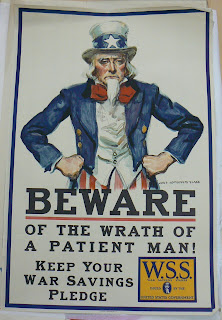By Rachel Dworkin, Archivist
By the time of the 1916 presidential campaign, the average
American had no interest in getting involved in the bloody quagmire which was
World War I. In fact, Woodrow Wilson won his reelection bid on the slogan “He
kept us out of the war.” It therefore came as an unpleasant surprise to many
when America declared war on April 6, 1917, just a month after Wilson’s second
inauguration. He would need to get America invested in the war and fast if the
country was to have any hope of winning. Enter the Committee on Public
Information.
Established by Executive Order 2594 on April 14, 1917, the Committee,
chaired by muckraking journalist George Creel, consisted of Secretary of State
Robert Lansing, Secretary of War Newton D. Baker, and Secretary of the Navy,
Josephus Daniels. Their mission was to launch a comprehensive PR campaign
across all media platform in order to win the hearts and minds of the populace.
The Committee had over twenty different divisions and bureaus, each focusing on
different ways to get their message out. There was a Film Division which worked
with Hollywood to make pro-war films, a Division of Syndicated Features which
produced short stories and op-ed pieces for literary magazines, a News Division
which issued daily press releases to newspapers, and so on.
The Division of
Pictorial Publicity was in charge of making posters and other advertisements.
It was headed up by Charles Dana Gibson, one of the more prominent commercial
artists of the day and president of the Society of Illustrators. Thanks to his pull
within the artistic community and publishing industry, Gibson was able to get
hundreds of prominent artists to produce posters and other advertisements for
free. In addition to big name American artists, he also recruited foreign
artists from allied and occupied nations. All told, the Division of Pictorial
Publicity produced over 14,000 posters promoting military recruitment, war
bonds, the Red Cross, war gardens, the U.S. Food Administration, and nearly a
dozen other war-related causes. The posters were displayed on billboards and in
schools, shops, factories, and just about everywhere really. As ubiquitous as the posters were, it was neigh impossible to read a magazine or newspaper and not see
one of the Division’s ads.
The Division of Pictorial Publicity took its cues from
techniques pioneered by the advertising industry. Forget facts; their posters
appealed to basic human emotions like fear, duty, guilt, patriotism, and the
need to keep up with the Joneses. Most were beautiful, some were humorous, but
all of them did their job. CCHS has a collection of over 50 posters, a handful of
which are currently on display in the new exhibit Propaganda War in the Education Room.




Interesting article on WW I, I did not know of war gardens or war bonds I did hear about ration cards not sure if they were also used during that time, and the fact President Wilson had to go back on his campaign slogan of keeping us out of the war (still happens today with our current politicians)
ReplyDelete